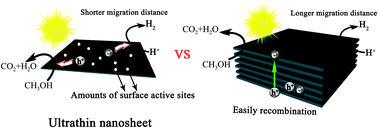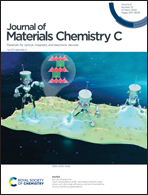Engineering surface defects on two-dimensional ultrathin mesoporous anatase TiO2 nanosheets for efficient charge separation and exceptional solar-driven photocatalytic hydrogen evolution†
Abstract
Two-dimensional (2D) ultrathin mesoporous anatase TiO2 nanosheets with engineered surface defects (SDUATNs) are prepared by evaporation-induced self-assembly, solvothermal and surface hydrogenation reduction strategies. The as-prepared SDUATNs possess a comparatively large specific surface area of 100.4 m2 g−1, a main pore size of 9.7 nm, and a pore volume of 0.36 cm3 g−1. After surface hydrogenation, the narrowed bandgap of 2.97 eV expands the photoresponse from the ultraviolet to the visible-light region as a result of efficient surface defect engineering. The SDUATNs exhibit excellent photocatalytic hydrogen production performance (3.73 mmol h−1 g−1), which is about 3-fold higher than that of pristine ultrathin mesoporous anatase TiO2 nanosheets (1.31 mmol h−1 g−1) under AM 1.5G irradiation. The improvement of the hydrogen evolution performance is attributed to the efficient engineered surface defects and the special 2D ultrathin structure reducing the bandgap, increasing sunlight utilization, providing adequate surface active sites, shortening the migration distance of charge carriers and thus favoring the spatial separation of photogenerated electron–hole pairs. The high stability also favors practical applications. This work presents new insight to enhance the photocatalytic performance and may provide valuable ideas to fabricate other high-performance 2D photocatalysts.



 Please wait while we load your content...
Please wait while we load your content...